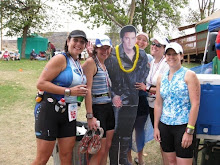Every day, you walk a metaphorical balance beam. Family life teeters against work commitments. That scoop of ice cream is pitted against a cup of broccoli. And, if your math is correct (and if that check is deposited in time), your checkbook is even balanced. For most of us, literal balance is taken for granted, handled by our automatic onboard computer.
"Even when you're standing still, you're using your sense of balance," says Harvey W. Wallmann, a doctor of physical therapy science and an associate professor at the University of Nevada, Las Vegas. "You use balance all the time, picking up children, stepping up on a curb, or walking over rocks."
What's Behind Balance
Like muscle, balance may also decline with age, Wallmann says. The surprising news: Even if you're working out in a gym, you may not be maintaining or improving your balance."When you're younger, you usually do all sorts of activities that challenge your balance system," Wallmann says. "Sitting in front of a computer all day, then going to the gym for 30 minutes does little to challenge your balance."
Bettering balance begins with a tripod--the three different sensors that form your personal gyroscope. Your inner ear, perception from your eyes, and joint and muscle-nerve receptors called proprioceptors combine to give you balance. If one of these elements goes out of whack, you'll likely teeter.
"Think about when you get out of bed at night in the dark," Wallmann says. "Some people are very vision dominant. You don't have your vision, so you'll likely wobble until you see a glint of light."
Also, for example, if you injure an ankle it diminishes the capability of the proprioceptors in that area to assist with balance. "You have to challenge your sensory system to force yourself out of your comfort zone," he says. "Once strengthened, you'll have better body control and also may be more likely to avoid falls and injuries."
Exercises to Try
To improve balance, Wallmann often recommends exercises that remove one of the tripod legs to help strengthen the others. Here are four he suggests:Single-leg Stand
Stand with your legs slightly less than shoulder-width apart near a support such as a wall or railing. Balance as you lift one leg, and then close your eyes. Maintain your balance for 30 to 60 seconds, and repeat with the other leg.
Trunk Turns
Stand with your legs slightly wider than shoulder-width apart on a mini trampoline. (No mini trampoline? A soft gym mat or other squishy surface will also work.) Hold an exercise ball, or a 5 or 10 pound weight chest high in both hands. Twist at your trunk to face your right. Return to center, then twist to your left and back to center. Repeat 10 to 20 times.
Single-leg Squat
Stand on a sturdy 6- to 8-inch-high stool or step, with your right leg off the stool to the side. Bend your left leg as you do a squat until your right leg barely touches the ground. Do two sets of five to 10 reps on each leg.
March in the Dark
In a room with plenty of space and no obstacles that could bump knees or cause you to trip, march in place 60 to 100 steps with your eyes closed.
EatBetterAmerica is the destination to find simple ways to eat better to live better. It’s a website where people can find healthy recipes, expert advice, community support and easy-to-follow exercise tips that can lead to a better and fuller life. So, now you’re not alone in this quest. Check out www.eatbetteramerica.com.





















1 comment:
Great tips on balance. Runners especially need good balance--after all, what is running but balancing on one leg over and over again? Weak stabilizers and you can get hurt.
Post a Comment